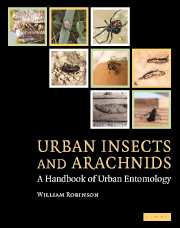Book contents
- Frontmatter
- Contents
- Preface
- Part I Urban entomology
- Part II Insects in the urban environment
- 4 Blattaria
- 5 Coleoptera
- 6 Collembola, Dermaptera
- 7 Diptera, Ephemeroptera
- 8 Hemiptera, Homoptera
- 9 Hymenoptera
- 10 Isoptera
- 11 Lepidoptera
- 12 Mantodea, Neuroptera
- 13 Orthoptera, Phasmatodea
- 14 Phthiraptera
- 15 Plecoptera, Psocoptera
- 16 Siphonaptera
- 17 Thysanoptera, Thysanura, Trichoptera
- Part III Other arthropods in the urban environment
- Family, genus, species index
- Index
- References
6 - Collembola, Dermaptera
Published online by Cambridge University Press: 06 August 2009
- Frontmatter
- Contents
- Preface
- Part I Urban entomology
- Part II Insects in the urban environment
- 4 Blattaria
- 5 Coleoptera
- 6 Collembola, Dermaptera
- 7 Diptera, Ephemeroptera
- 8 Hemiptera, Homoptera
- 9 Hymenoptera
- 10 Isoptera
- 11 Lepidoptera
- 12 Mantodea, Neuroptera
- 13 Orthoptera, Phasmatodea
- 14 Phthiraptera
- 15 Plecoptera, Psocoptera
- 16 Siphonaptera
- 17 Thysanoptera, Thysanura, Trichoptera
- Part III Other arthropods in the urban environment
- Family, genus, species index
- Index
- References
Summary
COLLEMBOLA
Introduction
Springtails are 0.75–6 mm long, wingless and soft-bodied insects. The abdominal segments are fused and there are not more than six segments visible. Antennae have 4–8 segments. The common name is derived from a forked structure, the furcula, which helps to propel them through the air. The furcula is on the fourth ventral abdominal segment, and when at rest it is folded under the abdomen. Jumps are made by forcefully extending the furcula downward and backward to strike the substrate, which lifts the insect. The jumping ability is strongly developed in terrestrial springtails, which jump to escape from predators. Entomobrya dorsalis is 2 mm long, but it can travel a distance of more than 16 cm. When disturbed, most springtails can be airborne within 50 ms, and Allacma fusca takes only 12 ms to respond with a jump. On the ventral side of abdominal segment 1 there is an eversible vesicle, called the collophore. This hold-fast structure provides for water absorption from moist substrates. Eyes are reduced to 1–8 ommatidia or absent. Mouthparts are mandibulate or suctorial and styletlike. Collembola have simple metamorphosis and the immature stages resemble the adults.
Mating behavior ranges from males randomly placing stalked spermatophores in the environment for females to discover, to males and females involved in elaborate courtship and mating involving a stalked spermatophore, or direct transfer to the female. Females do not retain sperm during ecdysis, and must collect a spermatophore after each molt to continue to lay fertilized eggs.
- Type
- Chapter
- Information
- Urban Insects and ArachnidsA Handbook of Urban Entomology, pp. 139 - 146Publisher: Cambridge University PressPrint publication year: 2005



